There are important specifications for manufacturers that all the producers should be aware of. This identity shows the right factors in this area. When it comes to canned foods, tomato paste is the most popular item. As a result, the difficulty of developing a tomato paste production line has always captivated the interest of a substantial number of business owners, Because there are currently so many well-known brands competing in the tomato paste market, many people may discover that it is incredibly difficult to succeed in this field.  However, the most major advantage of using the tomato paste production line is that it may be used in a variety of contexts and ways. Tomato paste can be produced in a variety of traditional, semi-industrial, and industrial processes, with capacities ranging from ten tons to one thousand tons. Many types of tomato paste production lines could potentially be profitable during the feasibility stage of the project, according to a written justification plan. Depending on the amount of money invested, the tomato paste production line could include machines of diverse capacities that operate in a number of industries. On the other hand, the manufacturing process for tomato paste is virtually the same throughout all lines.
However, the most major advantage of using the tomato paste production line is that it may be used in a variety of contexts and ways. Tomato paste can be produced in a variety of traditional, semi-industrial, and industrial processes, with capacities ranging from ten tons to one thousand tons. Many types of tomato paste production lines could potentially be profitable during the feasibility stage of the project, according to a written justification plan. Depending on the amount of money invested, the tomato paste production line could include machines of diverse capacities that operate in a number of industries. On the other hand, the manufacturing process for tomato paste is virtually the same throughout all lines. 
tomato paste manufacturers
the manufacturers of tomato paste should use special methods in order to have a great amount of tomato paste. Before you start establishing a tomato paste production line, you should be aware of the following information: Any and all necessary devices, such as those used for dewatering, must correspond to the relevant parameters (building material, engine power, efficiency, type, and grade of steel plate). Check that the device you purchase can handle the volume of data entering and exiting the system. Consider a location that is appropriate in light of the products in question. When expenses, sales, and marginal earnings are estimated, this technique has significant economic feasibility. How much does it cost to run the tomato paste line and how much does it cost to buy? When it comes to the development of a tomato paste production line, one of the most essential considerations is the issue of fixed and running costs. This is due to the fact that expenses are one of the most important factors to consider. In general, it is determined by the capacity cost of the tomato paste production line, the number of people involved, whether the machine is brand new or used, the type of operation that the production line is used for, and the location and position of the production line. Last but not least, in addition to the functioning of the tomato production line, it is critical to consider the potential of working with a company that can offer fresh tomatoes on a consistent basis. This gets us to the final consideration, which is critical to consider the potential of working with a company that can supply fresh tomatoes. This ensures that the work is completed in a continuous way and that there is no damage. 
tomato paste in drums
Because of the protective atmosphere created by the drum, tomato paste packaged in drums can keep fresh for a longer amount of time, both inside and outside of the refrigerator. This is by far the most significant advantage of using aseptic packaging. This package may contain a variety of other perishable goods in addition to tomato paste; it goes without saying that you have access to a variety of other options. Large samples should be preserved in the refrigerator; however, this procedure is not necessary for sterile types. While this is going on, the aseptic tomato paste business is bringing in more and more clients from other nations every day. Once the production process has been completed successfully, the finished tomato paste is put into these drums. This Tomato paste is an unsalted paste, which is one of its distinctive characteristics. Tomato Paste in Bulk and drums with Brix Contents ranging from 30% to 32% Sterile drums, The tomato paste has a Brix concentration of between 36 and 38 percent too. Weighs between 225 and 230 kg. The sterile filling of new drums with paste in preparation for export. The standard paste is intended for usage at factories but you can use it at home too. High expectations for the product’s quality and lifespan. Tomato juice is extracted from superior-quality tomatoes and concentrated. Tomato paste with no additional ingredients added in addition to those already present. It contains no salt and none of the standard artificial preservatives. After the tomato paste has been packaged and sealed in the appropriate bags, it is transferred to sterile vats for storage. The drums are blue metal in most cases. Overall, the texture has the appearance of being incredibly thick and robust. Used in the production of extraordinarily high-quality sauces and other items. 
tomato paste finish
the process of manufacturing tomato paste should finish with a high-quality and delicious flavor which is tomato paste. A diagram showing the procedures required in the manufacturing of tomato paste. Pastes with flavors: Some individuals prefer to finish making the dish by adding pepper as the very last ingredient to give it a hotter flavor. If you want your paste to be shiny and full of vibrant colors, it is best to apply the saffron towards the very end of the process. Tomatoes should be raw and brash, with a lot of flesh and rough skin. If this occurs, the paste will take on a dark appearance. After the cooking procedure has been completed, the paste should be placed in a glass jar. Do not use any plastic containers once they are empty. You cannot use the sunlight approach because it is necessary to heat the paste. Toxins carried by air as well as those naturally present in the environment may be absorbed by the paste in this manner. Oil: Apply a very small amount of oil to the surface of the paste after it has been boiled to avoid mold formation. Copper capacity: The paste pot must always be made of white copper. If you don’t do it, the paste will lack that nice appearance. Salt should not be added to the paste until it has started to become firmer. As the paste continues to rise in temperature, its color will darken. Keep in mind that the jar containing the paste must be completely filled before use. As you work your way through the recipe and add each ingredient, the color of the paste will gradually darken. 
tomato paste standard of identity
all the kinds of tomato paste must have a standard of identity as well. Tomatoes are one of the agricultural products that are consumed in both their natural and processed forms at a rate that is among the highest in the world. Salads of all kinds are becoming more popular, which has led to a rise in their use, which has also resulted in an increase in the use of fresh tomatoes. Furthermore, as a result of global familiarity with tomato products and the expansion of the export business, consumption of tomato-based items such as sauces and tomato pastes is increasing. Because of this familiarity, the demand for tomato products has increased. Tomato paste is one of the most important tomato products, and it can be manufactured in a variety of ways, including bulk, aseptically sealed food, and canned food. Each country’s authoritative agencies develop specific requirements for the quality of processed commodities, such as tomato products. Hopefully, our company got all kinds of standards for producing tomato paste and you can feel it by the quality of our products. The Food and Drug Administration (FDA) has set a standard for canned tomato paste based on a grading system that awards points ranging from 0 to 100 and focuses solely on internal and external color as well as any flaws. This approach rates the goods only on their appearance. The National Standards Organization, on the other hand, has established a standard for canned tomato paste that is far more detailed. The structure is exactly the same as it was before. There are seven basic categories to choose from. We are so honored to tell you that our company got all these standards which is a great point for a producer. 
tomato paste specification
tomato paste, like other products, has its own specification. When using high-quality tomato paste, the paste should retain the original color of the tomato, and when frying, care should be made to avoid spreading the paste throughout the oil. While using elevated tomato paste, the paste should keep the natural color of the tomato. To put it another way, it should not be excessively red, nor should it be too purple, as the latter would imply the addition of new colors. The product’s quality is worse than it should be since zucchini is used in the manufacturing process of some other manufacturers’ tomato paste. In order to determine which paste was mixed in with the pumpkin, dissolve one spoonful of paste in one glass of water. This will allow you to determine which paste was utilized. Pumpkin was used as an ingredient if the water was somewhat orange or yellow in color; tomato paste was used if the water was slightly orange or reddish in color. To be considered of the highest quality, tomato paste must meet specified specifications for consistency, flavor, and color. The raw forms of the components used to make Essential Tomato Paste ensure that it is of the highest quality possible. It is critical to maintain strict adherence to requirements at all stages of manufacture. Any use of additives is absolutely prohibited. To keep the product’s quality after baking, the temperature at which it is baked must be adjusted. The color should be natural, extremely close to the color of a fully ripe tomato, and neither overly light nor excessively dark. It is not advised to use thickeners too. 
hot break tomato paste
There are several methods for making tomato paste, one of which is known as the hot break method. A cold pressing method is an extra method. These components, as well as a range of other devices and transducers used in the food sector, are heated indirectly in hot brake heating systems. This column is constructed with a tube and shell design. To generate a flow, a tube and shell type of centrifugal pump unit made entirely of steel is now used. This type of unit is specifically employed to make the flow happen. The tomatoes are prepared using the hot break method, which involves placing the chopped tomatoes in a temperature range of 90 to 95 degrees Celsius. For the tomatoes to achieve the desired temperature, this temperature range is required. Tomato juice collected from the previous stage must be stored in the appropriate location so that it may be provided to the succeeding processes in the production line at the appropriate time. To do this, the tomato juice removed from the two-stage strainer is transported to a storage tank and stored for a specific duration. A revolving stirrer is always present within the tomato juice storage tank. This is done to keep the tomato juice from moving on to the next stage, which is the settling stage. Filtration is the process of separating the tomato’s peel, flesh, and small particles from the filtered liquid. In the first stage of the filter, tomato juice passes through a hole with a diameter of 1 mm, and then it passes through a hole with a diameter of 0.6 mm. The tomato juice is subsequently thrown against the machine’s wall at great pressure. All these steps have been done in our production lines in our factories with the right method.

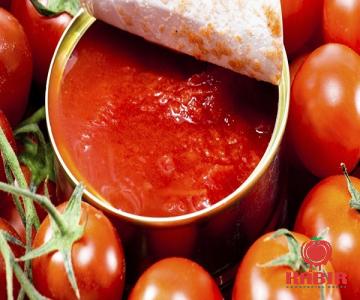
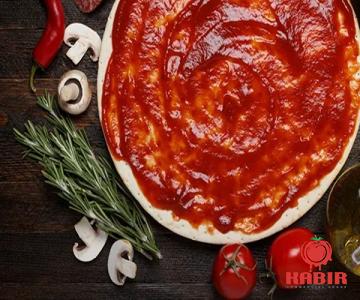


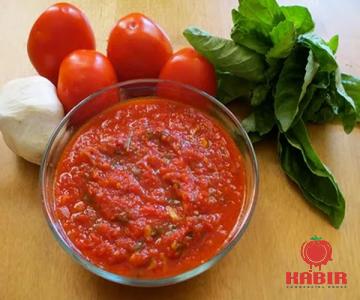
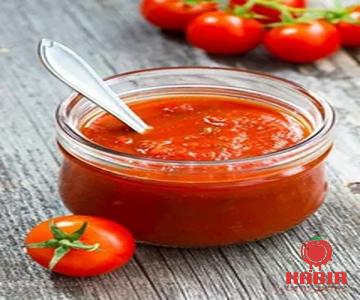
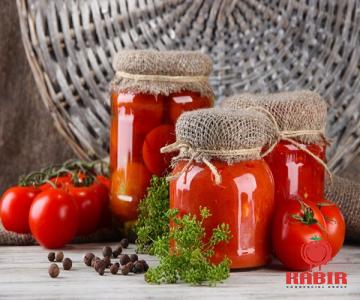
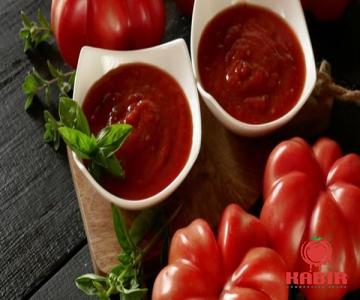
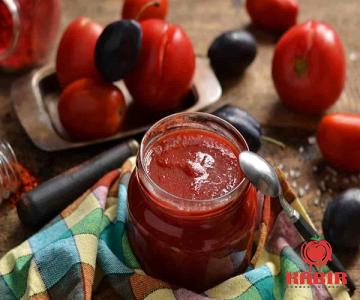
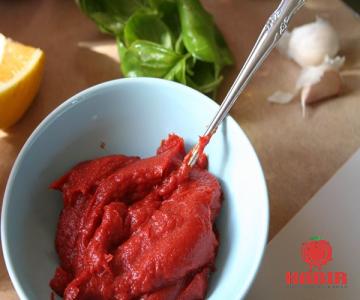
Your comment submitted.